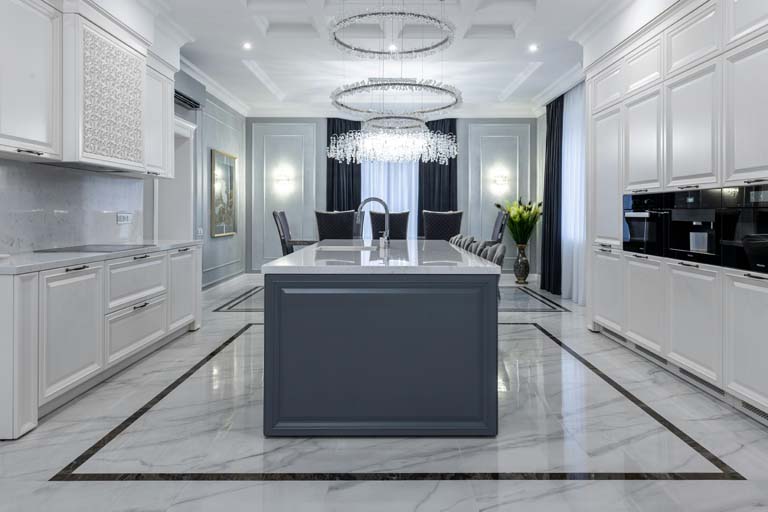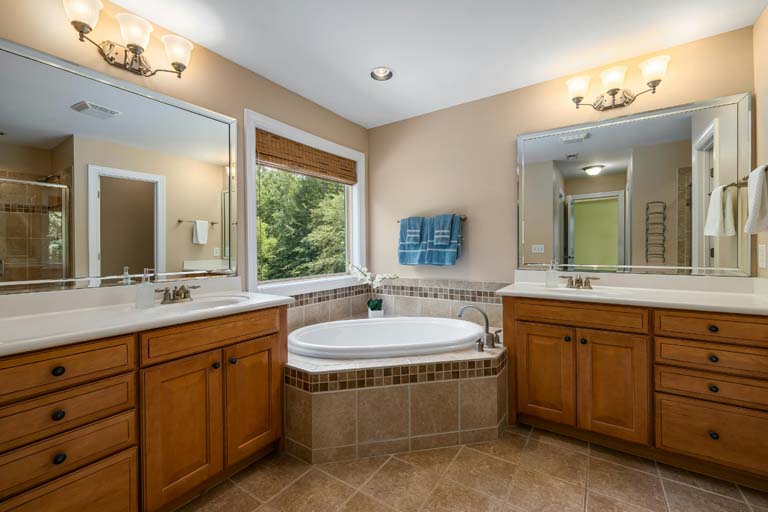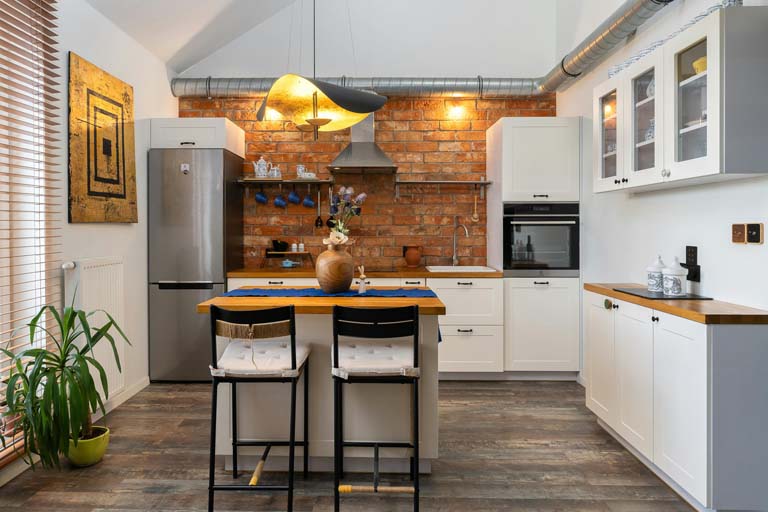Experts go back and forth on this one. Some believe high-strength concrete floors last the longest, while others believe solid-body porcelain tiles are the champion of toughness when it comes to homeowner flooring. Both can last a lifetime.
Some brave trendsetters are willing to go with poured concrete floors in their homes. However, this choice is not for the faint of heart. Installation is a big, messy process, and it’s pretty much permanent. Concrete inside your home is also not maintenance-free. For the sake of this article, we’re going to focus on non-concrete options.
Ceramic Tile Flooring: Glazed Ceramic, Porcelain, Terracotta, and Quarry Tiles
All four – unglazed ceramic, porcelain, terracotta, and quarry tiles are considered ceramic tiles, but they can be very different in look, texture, and performance.

Terracotta Tiles:
Terracotta means “cooked earth.” These tiles are often ½ an inch or more in thickness. The color comes from the natural clays used to produce them, and the color is uniform all the way through. This means that if you get a chip in the surface or a corner of the tile, the deep rich red color will be identical to the surface.
These tiles readily absorb water and other liquids. They wear down easily in high-traffic areas, and this is considered part of their appeal. Generally speaking, these tiles are less expensive than other forms of ceramic tile flooring. When installed, these tiles have very wide grout lines that can be prone to staining if not sealed during installation.
Quarry Tiles:
This can be a little confusing. Quarry tiles look very similar to terracotta tiles. The deep, rich reddish brown is practically the same, but that’s where the similarity ends. Quarry tiles are harder than terracotta tiles, and they are impervious to water and other liquids. They are fired at higher temperatures than terracotta, and this makes them tougher.
Although some clay is used, other minerals like shale, granite, and feldspar are finely ground and mixed together, then baked at high temperatures. They are a durable flooring option, and they can be used indoors and outdoors. Typically entrance ways, kitchens, and mud rooms are good candidates for quarry tiles.
Glazed Ceramic Tiles:
Through many decades, glazed ceramic tiles have remained one of the most popular types of flooring. One of the reasons is that their durability is unparalleled. However, when it’s time to choose a glazed ceramic tile for your project, it’s a good practice to double-check the specifications indicated on the packaging.
For example, some high-quality tiles are not recommended for outdoor use in areas where freezing temperatures are common, while other ceramic tiles are too smooth and too slippery for wet conditions. Picking the right kind of tile can be complicated, so it’s always a good idea to ask a flooring expert. One of the best features of glazed ceramic tiles is the almost unlimited variety of colors and patterns available.
This vast array is made possible by how glazed ceramic tiles are produced. Glazed ceramic tiles are fired in a kiln at extreme temperatures until a glass-like top layer is formed. This glass-like surface (also known as a glaze) protects the patterns and colors of the tile. This glaze also makes the tiles impervious to water, and easy to clean.

Porcelain Tiles:
These come either glazed or full-body. Almost always, these tiles are made in a very similar manner to ceramic tiles, but the materials used are of higher quality, and they are fired at higher temperatures. Generally, this can make them more expensive, but it depends on the popularity of the look and color.
Full-body porcelain tiles are extremely durable, and they do not have a top glaze. Their color palette is limited to the natural color of the higher-quality clays and minerals used to create them. As with terracotta tiles, full-body porcelain tiles are uniform all the way through. In the unlikelihood of damage or scratches, the color revealed in the scratch will be exactly the same as the color on the surface.
Subway Tiles, Mosaic Tiles, and Large Format Field Tiles
Just about anything goes when it comes to the size and shape of tiles. Subway tiles used to be white, and the most common size was 3 inches by 6 inches. Today, this familiar format and running brick installation are complemented with all sorts of colors and materials, including glass and mirrors.
Even the installation patterns are now more varied. Running bond, 90-degree herringbone, 45-degree herringbone, basket weave, and stack bond are just a few of them. These patterns create plenty of visual interest even with plain, uniformly colored tiles.
Natural Stone Tiles
In the last few years, the industry has introduced a wide variety of natural stone tiles. Marble, exotic granite, and travertine tiles are now available in more colors, textures, and finishes than ever before. What used to be limited to kitchen backsplash tiles and kitchen countertops are now being used as bold accents and complete floors in other parts of the home.

Wood Look Tile
One of the most interesting developments in the last few years is the introduction of wood-like ceramic tiles. When they were first launched, they sort of kind of looked like solid hardwood floors.
After some impressive refinements in both the look of the tile and the new approach to grout lines as part of the installation, the upper end of these tiles is practically indistinguishable from a solid wood floor. You have to get down on the floor for a close look and feel to be able to tell the difference. This is one of the most exciting flooring trends in recent years.
Last But Not Least, Resilient Flooring
High-quality LVT (waterproof flooring) and linoleum are favorites among homeowners who are looking for a durable and budget-friendly flooring option. With normal use, the wear layer and sturdy construction of these floors can last well over 20 years. Ultimately, ceramic tiles and natural stone may last longer, but when it comes to lower installation costs and a lower per-square-foot price of material, this might be the right option for you.
(214) 390-0850

Dan Ratcliff
President and CEO of Flooring Direct in Dallas / Fort Worth.
Over the last two decades, he has grown Flooring Direct into a premier Shop-at-Home traditional & hardwood flooring company. With a true dedication to customer service and integrity, Flooring Direct has become DFW's largest highest-rated Dallas-local flooring dealer. Dan has lived in Dallas all of his life and was raised in Dallas with family roots and love for the community and local sports. It's with that sense of family that Flooring Direct has contributed to and sponsored children's organizations like Jonathan's Place and scholastic athletics like Plano's Girls Soccer.
- This author does not have any more posts.